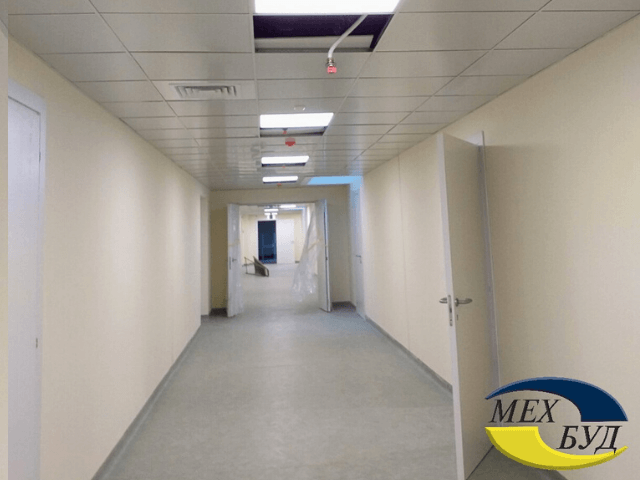Medical Ceilings – these are ceiling systems that can be installed in spaces with elevated sanitary and hygiene requirements. For example, clinics, hospitals, sanatoriums, medical centers, and dental offices – all these facilities require additional antimicrobial and antibacterial protection.
Materials used in medical facilities are subject to the strictest safety, operational, and cleaning requirements compared to other types of construction projects.
The “Mehbud” factory manufactures metal suspended ceilings that comply with all current sanitary norms (SNiP). Additionally, all our products have the necessary approvals from the State Sanitary and Epidemiological Service (SES) and the State Technogenic Safety of Ukraine.
REGULATORY DOCUMENTS
In Ukraine, the primary regulatory documents governing the installation of ceilings in medical institutions include:
- DBN V.2.2-3-2007 “Buildings and Structures. Hospitals and Clinics”: This document sets requirements for the design, construction, and operation of hospitals and clinics, including interior finishes such as ceilings.
- DBN V.2.5-67:2013 “Sanitary Standards for the Design of Hospitals and Clinics”: This document establishes sanitary requirements for the design of hospitals and clinics, including requirements for materials used in interior finishes.
- DSTU B V.2.6-212:2016 “Building Materials. Suspended Ceilings. Technical Specifications”: This standard specifies requirements for suspended ceilings, including their properties and installation.
- DSTU B V.2.6-22:2001 “Building Materials. Suspended Ceilings with Metal Plates. General Technical Conditions”: This standard sets requirements for metal suspended ceilings, including their properties and installation.
- DSTU B V.2.7-19-95 “Building Materials. Floor and Ceiling Coverings. Test Methods”: This standard establishes test methods for floor and ceiling coverings, including requirements for their properties and installation.
These regulatory documents establish requirements for interior finishes in medical institutions, including requirements for ceiling materials, their properties, and installation. They cover aspects such as hygiene, fire safety, ease of maintenance, and other important considerations.
It’s important to note that when choosing materials for ceilings in medical facilities, it’s necessary to consider the specific nature of the facility, including the types of medical procedures performed and the needs of patients and staff.
SELECTING CEILINGS FOR MEDICAL FACILITIES: KEY CONSIDERATIONS
Choosing the right ceilings for medical facilities is not just an aesthetic decision. It involves considerations of hygiene, safety, patient comfort, and the efficiency of medical personnel. Let’s examine some key features to consider when choosing ceilings for medical facilities.
- Sanitary Requirements: Medical facilities require a high level of sanitation and hygiene. Ceilings should be easy to clean and withstand regular disinfection. Materials that meet these requirements include metal, vinyl, and plastic.
- Fire Safety: Medical facilities often use various equipment that can pose a fire hazard. Therefore, ceilings should be made from non-combustible materials to reduce the risk of fire and its spread in case of electrical problems.
- Acoustic Properties: Providing a quiet and peaceful environment for patients is important in medical facilities. Ceilings with good acoustic properties can help reduce noise levels and create a more comfortable environment.
- Access to Ceiling Space: Medical facilities often require easy access to the ceiling space for servicing utilities and equipment. Suspended ceilings that allow for easy opening of individual panels can be an ideal solution.
- Aesthetics and Comfort: Lastly, don’t forget about aesthetics and comfort. Ceilings in medical facilities should not only be practical but also visually pleasing. They should contribute to creating a calm and inviting atmosphere for patients and staff. Choosing ceilings with pleasant colors and textures can help achieve this atmosphere.
Selecting the right ceiling for a medical facility is a crucial decision that impacts the safety, efficiency, and comfort of everyone within. By considering these features, you can make the best choice for your medical institution.
WHAT A CEILING IN A MEDICAL FACILITY SHOULD BE: MAIN REQUIREMENTS
There are several strict requirements for interior finishes in medical institutions such as hospitals, clinics, medical stations, etc., and these requirements also extend to ceilings. These requirements primarily focus on the sanitary condition of interior finishes, as this aspect is critical for such premises.
The ceiling in a space where any medical procedures are conducted should:
- Enable sanitary cleaning: Ceilings must allow for effective sanitation to maintain the overall cleanliness of the room. Cleaning the ceiling with disinfectants may not be as frequent as cleaning the floor or walls, but it should still be possible and effective, ensuring that the disinfectant can contact all surfaces.
- Ensure fire safety: Many medical facilities use concealed wiring for electrical equipment. Ceiling panels should be made of non-combustible materials to eliminate the risk of ignition and fire spread in case of electrical issues.
- Provide access to the ceiling space: This requirement is closely related to concealed wiring and other utilities. Often, quick access to the ceiling space is necessary for maintenance, or to install new wiring or ventilation ducts promptly. This can only be achieved if the ceiling construction allows for the swift removal of individual elements.
Additionally, standard requirements for ceiling structures, such as strength, durability, resistance to external influences, etc., should not be overlooked.
Only a few types of ceiling constructions fully meet all the above-mentioned requirements for medical institutions, with metal suspended ceilings being the prime example. They offer a unique combination of advantages, which we will describe below.


